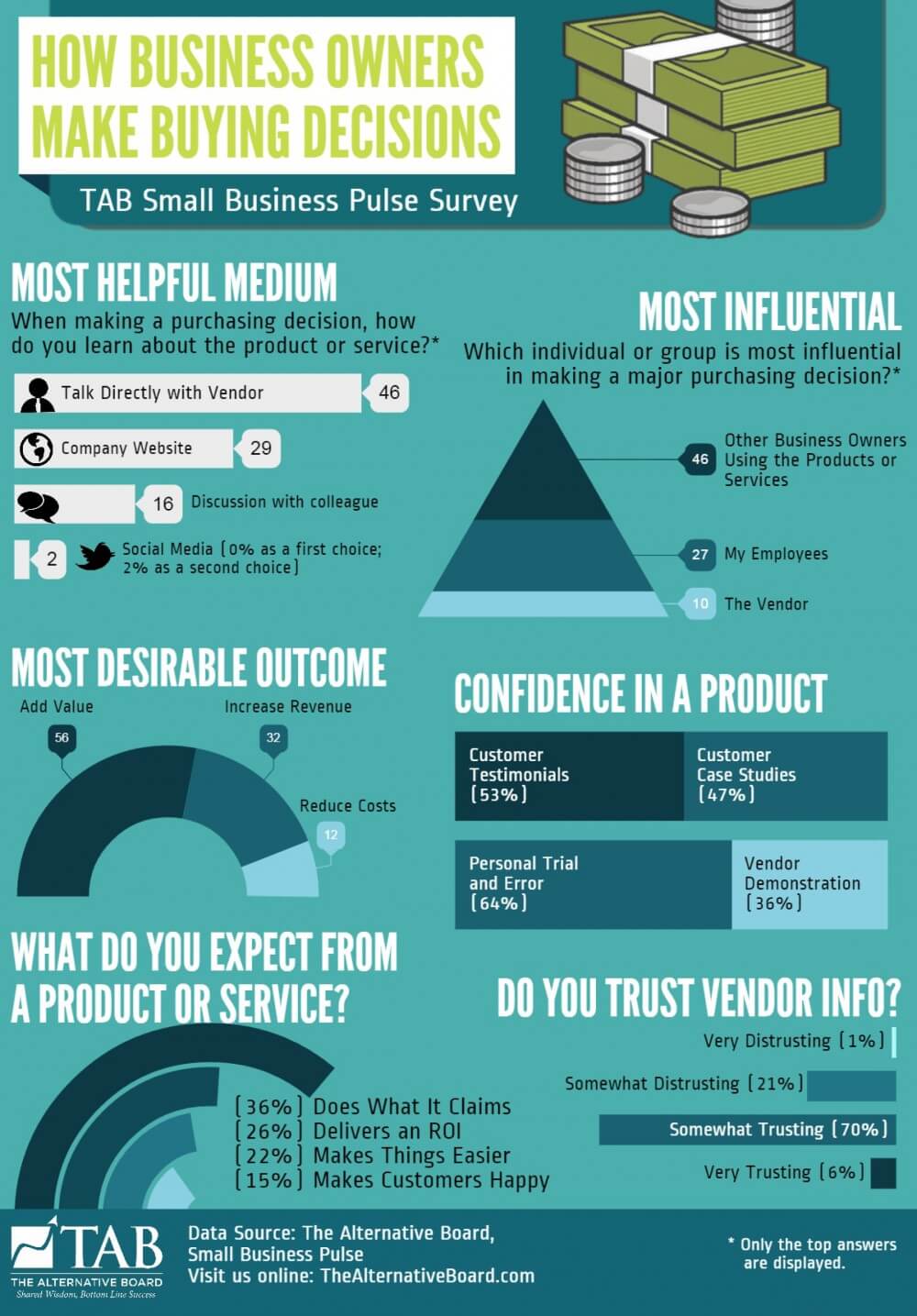This is a high-level summary of our key findings from the September 2014 Small Business Pulse Survey. This
survey concentrated on How Business Owners Make Buying Decisions. The survey was taken by 401 business
owners.
Profile of Survey Participants
- 54% of respondents have been in business for more than 20 years.
- 26% of the respondents have annual revenue of $5 million or more. An additional 43% have revenue
between $1 million and $5 million.
- 39% of respondents have 2-9 employees and 38% have 10-49 employees.
- The most common industry sectors are Professional Services, Manufacturing and Construction.
- We also assessed differences between buying behaviors of younger and older business owners so asked
about age. 52% of respondents are 55 or older and 48% are 54 or younger.
- Respondents came from the US, Canada, the UK, New Zealand and Ireland
Key Business Owner Buying Decision Attributes
The following buying decision characteristics emerged from this survey:
- When evaluating a new product or service for purchase, business owners want to about it from vendor
representatives, the company’s website and conversation with a colleague.
- Other business owners is by far the greatest single source in influencing the buying decisions.
Employees are the second most important source of influence.
- In making an important purchasing decision, the most important outcome is adding value. Increasing
revenue is second and is nearly three times as important as reducing cost.
- In terms of gaining confidence in a product or service, 64% selected personal trial & error compared to
36% selecting demonstration by the vendor.
- Owners tend to be more trusting than distrusting when receiving information from vendors. Vendors
receive the benefit of the doubt initially.
- Owners prefer to be contact by a vendor via email or a phone call. However, many do not want to be
contacted at all. It is therefore important for vendors to make it easy for their prospects to find them.
Key Findings
When making a major purchasing decision, which medium is most helpful in learning about the product or
service?
- 46% look to the vendor to educate them
- 29% look to the company’s website. While most business owners place a premium on the value of their
website, there is opportunity for many businesses to increase the quality of their website; and in many
cases, the content is dated and should be updated.
- 16% responded with a conversation with a colleague
- 9% provided other responses including event seminar, trade publication and email.
- 0% of respondents selected Social Media as their first source and2% as their secondary source. This
would seem to confirm our experience that Social Media is primarily used for brand awareness and
engagement and less for product and service education.
When making a major purchasing decision, which individual or group is most influential in helping you decide
to make that purchase?
- 46% of owners look to other business owners using the product or service to have the greatest
influence on their buying decision. This is becoming even more importance since 52% of owners aged 25-
54 chose this option compared to 41% of owners 55 and older. Vendors should place a premium on
developing an enthusiastic group of references that prospects can speak to.
- 27% look to staff/employees.
- Professional associations and industry organizations were not a very significant source of influence and
seem to be in decline as younger business owners look to them less.
- Only 10% chose the vendor. This is not surprising. Owners look to the vendor to educate them but look
to others to influence their buying decisions.
When making a major purchasing decision, which outcome is more important to you?
- 56% chose add value, 32% increase revenue and 12% reduce cost.
- Demonstrating that a product or service can increase revenue is nearly three times as important as
reducing costs.
Which of the following is gives you confidence in a product or service? Two questions were asked.
- 53% chose customer testimonials compared to 47% choosing customer case studies. They are both
important. Vendors should spend considerable time building their database of references, testimonials
and case studies. Video testimonials are much more effective than written testimonials.
- 64% chose personal trial and error compared to 36% choosing demonstration by the vendor. With so
many products and services offering free trials, business owners are becoming accustomed to a test
drive prior to making a purchase. Younger business owners are much more likely (69%) to have a
personal trial & error than older business owners (59%).
When you purchase a product or service, what do you expect most from that product?
- 36% selected does what it claims
- 26% selected delivers a return on investment
- 22% selected makes things easier for me and my staff
- 15% selected makes my customers/clients happier
Given the relative balance between these findings, vendors should look to fulfill each of these attributes when
designing new products or services.
How trusting are you of the information you receive directly from the vendor?
- 6% are very trusting, 70% are somewhat trusting, 21% are somewhat distrusting and 1% are very
distrusting.
- Owners are inclined to be trusting when receiving information from vendors. Vendors are given the
benefit of the doubt. It is up to them to maintain that trust throughout the buying lifecycle.
What feedback do you have on information received directly from the vendor?
- In terms of criticisms, business owners can find vendor information to be too sales-oriented (57%),
insufficient in detail (21%), over technical (10%) and repetitive (8%).
- Vendor information that is relevant (49%), informative (40%) and independent (9%) is received most
positively.
When reviewing a vendor’s website, which feature would make you most likely to trust the vendor?
- 68% selected an independent review
- 18% selected video demonstration
- 11% selected independent article written about the vendor
What is the most important way for a new vendor to initiative contact with you?
- 42% selected send me an email
- 26% selected I don’t want to be bothered by any vendors. Owners are very busy and many do not want
to receive unsolicited offers. It is therefore important that vendors promote information about their
product or service in places where their products are likely to visit (virtually or in-person) to have the
opportunity for owners to discover them.
- 19% selected call my office
- 10% selected write me a handwritten note
- Only 3% responded with request a connection via Social Media. Importantly, 5% of respondents in age
group 25-54 responded positively and 0% of 55+ owners.
TAB Australia
TAB Austria
TAB Canada
![Chile Chile]() TAB Chile
TAB ChileTAB Czech Republic
TAB England
TAB France
TAB Germany
TAB India
TAB Ireland
TAB Israel
TAB Mexico
TAB Moldova
![Netherlands Netherlands]() TAB Netherlands
TAB NetherlandsTAB New Zealand
TAB Portugal
TAB Romania
TAB Scotland
TAB Slovakia
TAB South Africa
TAB Spain
TAB Switzerland
TAB United States
TAB Wales







